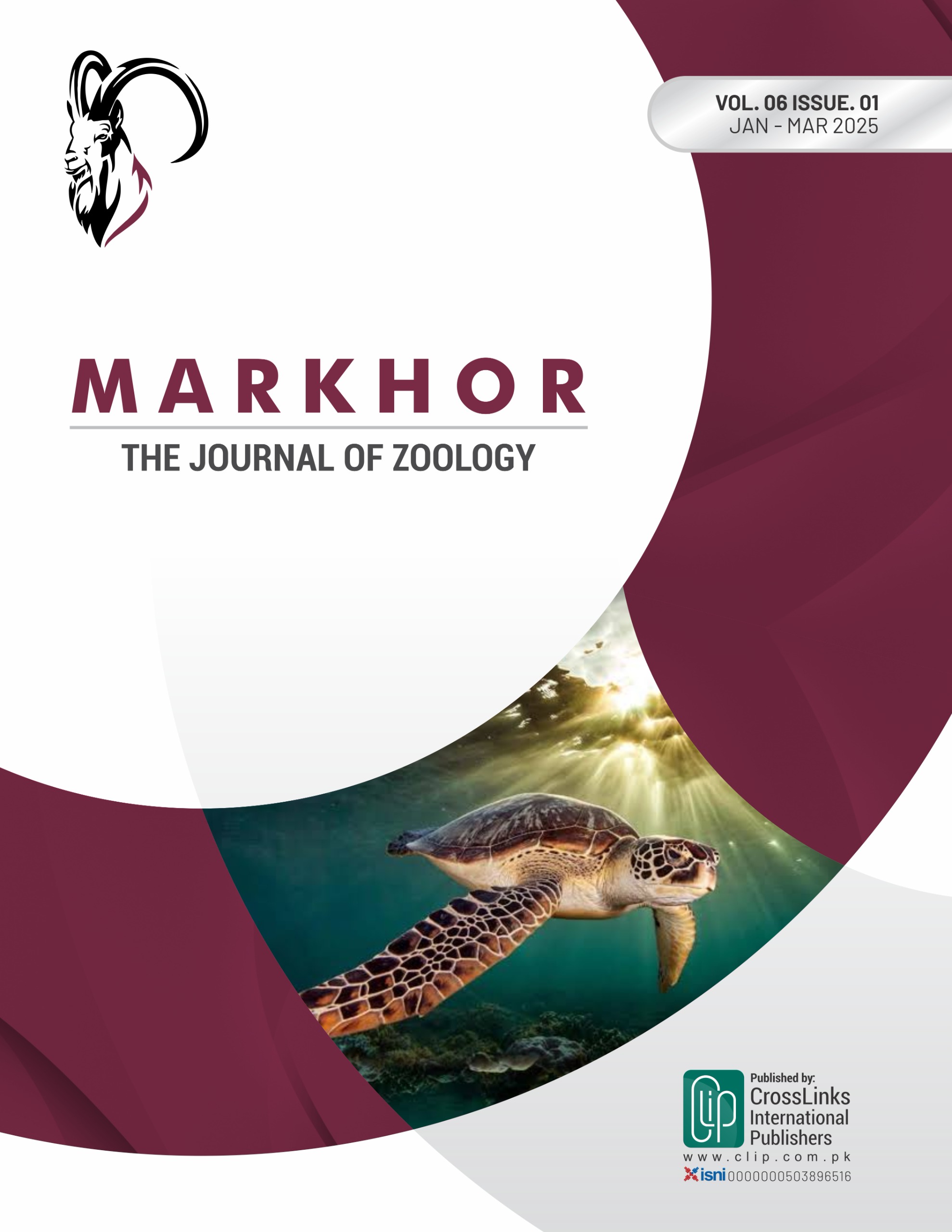Prevalence and Diversity of Ovine Gastrointestinal Parasites in the District Lower Dir
Prevalence and Diversity of Ovine Gastrointestinal Parasites
DOI:
https://doi.org/10.54393/mjz.v6i1.148Keywords:
Prevalence, Diversity, Gastrointestinal Parasites, SheepAbstract
Gastrointestinal parasitism is a key challenge to sheep production globally, These parasites result in weight loss, diarrhea, anemia, and higher production costs. Objectives: To find out the prevalence of gastrointestinal parasites in ovine of district lower Dir Khyber Pakhtunkhwa. Methods: A fecal sample was taken at random from the rectum of sheep (Ovis aries) using gloved fingers. The faecal components were then placed in sterile plastic bottles containing 10% formalin. A total number of 584 faecal samples of sheep were collected and then analyzed for the presence of parasites. Among them, 219 sheep were male, and 365 were female. Results: The Overall prevalence rate was 89.04%. Most commonly, parasites were Haemonchus spp., Strongyloides spp., Trichuris spp., Fasciola hepaticas spp., and Moniezia spp., which were 43.27, 28.57, 15.59, 3.6, and 1.7% prevalences, respectively. Based on sex, there was a significant difference (p<0.05) in the overall incidence of gastrointestinal parasites between male (33.39%) and female (55.65%) sheep. The prevalence of gastrointestinal parasites in adult sheep was higher (69.18%) than in young sheep (19.86%). The highest infection was observed in the Balkhi breed (38.7%) and the Damani breed (32.53%) in comparison to the Lokhi breed (18.32%) (p<0.05). In contrast, in the tehsil-wise comparison, the maximum number of gastrointestinal parasites prevalence (17.46%) was recorded in tehsil Samar Bagh, followed by tehsil Munda 15.23%, Lal Qila 13.01%, Balambat 9.1%, and tehsil Khall 8.4%. Conclusions: It was concluded that parasitic spp, sex, age, breed, and different tehsils are vital factors that affect the prevalence of gastrointestinal parasites.
References
Pandey AK, Kumar P, Saxena MJ. Feed Additives in Animal Health. Nutraceuticals in Veterinary Medicine. 2019:345-62. doi: 10.1007/978-3-030-04624-8_23.
Chandra K and Gupta D. Faunal Diversity at Ecosystem Level in India: Dynamics and Status. In Biodiversity in India: Status, Issues and Challenges. Singapore: Springer Nature Singapore. 2022 Sep: 463-492. doi: 10.1007/978-981-16-9777-7_18.
Lalor R, Cwiklinski K, Calvani NE, Dorey A, Hamon S, Corrales JL et al. Pathogenicity and Virulence of the Liver Flukes Fasciola Hepatica and Fasciola Gigantica That Cause the Zoonosis Fasciolosis. Virulence. 2021 Dec; 12(1): 2839-67. doi: 10.1080/21505594.2021.1996520.
Moje N, Gurmesa A, Regassa G. Gastrointestinal Tract Nematodes of Small Ruminants: Prevalence and Their Identification in and Around Alage, Southern Ethiopia. Animal and Veterinary Sciences. 2021 Jun; 9(3): 65-72. doi: 10.11648/j.avs.20210903.14.
Paul J. Gastrointestinal Tract Infections. Cham: Springer International Publishing. In Disease Causing Microbes. 2024 Jan: 149-215. doi: 10.1007/978-3-031-28567-7_4.
Bricarello PA, Longo C, da Rocha RA, Hötzel MJ. Understanding Animal-Plant-Parasite Interactions to Improve the Management of Gastrointestinal Nematodes in Grazing Ruminants. Pathogens. 2023 Mar; 12(4): 531. doi: 10.3390/pathogens12040531.
Arrais M, Maricoto T, Nwaru BI, Cooper PJ, Gama JM, Brito M et al. Helminth Infections and Allergic Diseases: Systematic Review and Meta-Analysis of the Global Literature. Journal of Allergy and Clinical Immunology. 2022 Jun; 149(6): 2139-52. doi: 10.1016/j.jaci.2021.12.777.
Williams AR, Myhill LJ, Stolzenbach S, Nejsum P, Mejer H, Nielsen DS et al. Emerging Interactions Between Diet, Gastrointestinal Helminth Infection, and the Gut Microbiota in Livestock. BioMed Central Veterinary Research. 2021 Dec; 17: 1-9. doi: 10.1186/s12917-021-02752-w.
Ruhoollah, Khan W, Al-Jabr OA, Khan T, Khan A, El-Ghareeb WR, Aguilar-Marcelino L et al. Prevalence of Gastrointestinal Parasite in Small Ruminants of District Dir Upper Khyber Pakhtunkhwa Province of Pakistan. Brazilian Journal of Biology. 2021 Oct; 83: e248978. doi: 10.1590/1519-6984.248978.
Fadladdin YA, Shah MZ, Khan K, Saleem M. Diversity, Prevalence, and Risk Factors of Gastrointestinal Parasites in Sheep Herds Grazing in Upper Dir District, Northern Pakistan. Egyptian Journal of Veterinary Sciences. 2025 Jan: 1-7. doi: 10.21608/ejvs.2025.325674.2401.
Miller H, Mulhall J, Pfau LA, Palm R, Denkenberger DC. Can Foraging for Earthworms Significantly Reduce Global Famine in A Catastrophe?. Biomass. 2024 Jul; 4(3): 765-83. doi: 10.3390/biomass4030043.
Craig TM. Gastrointestinal Nematodes, Diagnosis and Control. The Veterinary Clinics of North America. Food Animal Practice. 2018 Mar; 34(1): 185-99. doi: 10.1016/j.cvfa.2017.10.008.
Ullah S, Khan TM, Khan U, Rahman K, Ullah N, Ahmad T. The Perception of Local Community About Climate Change and Its Impacts On Their Lives at Tehsil Timergara, District Dir (Lower), Khyber Pakhtunkhwa Pakistan. Asian Journal of Agriculture and Biology. 2015; 3(1): 15-22.
Galindez JA, Arteaga LR, Cañas RV. ParasitoBank Dataset for Diagnosing Intestinal Parasitism: Helminths and Protozoa in Coprological Samples. Data in Brief. 2025 Feb; 58: 111279. doi: 10.1016/j.dib.2025.111279.
Khan T, Khan W, Iqbal R, Maqbool A, Fadladdin YA, Sabtain T. Prevalence of Gastrointestinal Parasitic Infection in Cows and Buffaloes in Lower Dir, Khyber Pakhtunkhwa, Pakistan. Brazilian Journal of Biology. 2022 Feb; 83: e242677. doi: 10.1590/1519-6984.242677.
Kann S, Hartmann M, Alker J, Hansen J, Dib JC, Aristizabal A et al. Seasonal Patterns of Enteric Pathogens in Colombian Indigenous People—A More Pronounced Effect on Bacteria Than on Parasites. Pathogens. 2022 Feb; 11(2): 214. doi: 10.3390/pathogens11020214.
Trinidad SE, Bravo CB, Narvasta SF, Fuertes EH, Trigoso GA, Sáenz FC et al. Seroprevalence of Reproductive and Infectious Diseases in Cattle: The Case of Madre De Dios in the Peruvian Southeastern Tropics. American Journal of Veterinary Research. 2024 Apr; 85(4). doi: 10.2460/ajvr.23.08.0177.
Abebe T, Yobsan T, Debela A. Prevalence of Major Gastrointestinal Nematode and Degree of Parasite Infestation in Sheep of Bako Agricultural Research Center Community-Based Breeding Program Project Small Holder Farms at Horro District. Dairy and Veterinary Sciences Journals. 2018; 8: 555740. doi: 10.19080/JDVS.2018.08.555740.
Zannou O, Sow A, Rekik M, Amole TA, Doyle R, Hoek RV et al. Manual of Integrated Package for Herd Health, Reproduction and Feed Management of Small Ruminants in Mali. 2024. doi: 10.1155/tbed/9903861.
Rana G and Subedi JR. Gastrointestinal Parasites of Sheep (Ovis aries, Linnaeus, 1758) in Laxmipur VDC, Dang, Nepal. Nepalese Veterinary Journal. 2020: 8-20. doi: 10.3126/nvj.v37i37.55175.
Acharya N, Poudel SP, Acharya KP. Cross-Sectional Sero-Prevalence Study of Peste Des Petits Ruminants (PPR) in Goats of Syangja And Kaski Districts of Nepal. Virus Disease. 2018 Jun; 29: 173-9. doi: 10.1007/s13337-018-0449-1.
Ibrahim N, Tefera M, Bekele M, Alemu S. Prevalence of Gastrointestinal Parasites of Small Ruminants in And Around Jimma Town, Western Ethiopia. Acta Parasitologica Globalis. 2014; 5(1): 12-8. doi: 10.5829/idosi.apg.2014.5.1.82346.
Kenea T, Bekele J, Sheferaw D. Gastro-Intestinal Nematodes of Sheep and Goats in Three Districts of Kaffa and Bench Maji Zones, Southwest Ethiopia. Ethiopian Veterinary Journal. 2015 Dec; 19(2): 67-76. doi: 10.4314/evj.v19i2.6.
Ayvazoğlu C, Kızıltepe Ş, Demir PA, Eser G. Prevalence and Economic Importance of Fasciolosis in Slaughtered Sheep in Iğdır Province of Turkey. Euroasia Journal of Mathematics, Engineering, Natural & Medical Sciences. 2023 Mar; 10(26): 87-95. doi: 10.5281/zenodo.7771735.
Mohammed UA, Fidelis AV, Victor JG. Studies on the Prevalence of Gastrointestinal Nematodes in Ruminant Animals Slaughtered in Biu Local Government Abattoirs, Borno State, Nigeria. Fudma Journal Of Sciences. 2023 Apr; 7(2): 141-5. doi: 10.33003/fjs-2023-0702-1707.
Dey AR, Begum N, Biswas H, Alam MZ. Prevalence and Factors Influencing Gastrointestinal Parasitic Infections in Sheep in Bangladesh. Annals of Parasitology. 2021; 67(2). doi: 10.17420/ap6702.328.
Choubisa SL. A Brief and Critical Review of Endemic Fluorosis in Domestic Animals of Scheduled Area of Rajasthan, India: Focus On Its Impact On Tribal Economy. Clinical Research of Animal Sciences. 2023 Apr; 3(1): 1-1. doi: 10.31031/CRAS.2023.03.000551.
Hussain S, Zaheer R. Role of Rural Women in Development and Export Earnings of Pakistan's Dairy Industry. Pakistan Journal of Gender Studies. 2020 Mar; 20(1): 211-28. doi: 10.46568/pjgs.v20i1.429.
Bhat RA, Tak H, Bhat BA, Dar JA, Ahmad R. Gastrointestinal Helminth Parasites of Wild Ungulates in Hirpora Wildlife Sanctuary, Kashmir, India. Journal of Parasitic Diseases. 2022 Sep; 46(3): 804-10. doi: 10.1007/s12639-022-01493-3.
Nyagura I, Malatji MP, Mukaratirwa S. The Prevalence and Infection Rates of Amphistome Species in Intermediate Snail Hosts: A Systematic Review and Meta-Analysis. Frontiers in Veterinary Science. 2024 Jun; 11: 1418979. doi: 10.3389/fvets.2024.1418979.
Downloads
Published
How to Cite
Issue
Section
License
Copyright (c) 2025 MARKHOR (The Journal of Zoology)

This work is licensed under a Creative Commons Attribution 4.0 International License.
This is an open-access journal and all the published articles / items are distributed under the terms of the Creative Commons Attribution License, which permits unrestricted use, distribution, and reproduction in any medium, provided the original author and source are credited. For comments editor@markhorjournal.com











